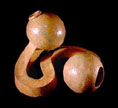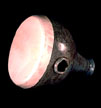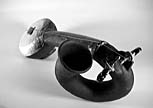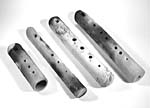
Globular Horns
by Barry Hall
Originally published in the Summer 1999 issue of Experimental Musical Instruments, edited by Bart Hopkin, and in the recording from EMI, Volume 14. Also featured in the EMI CD release "Later Years"
 |
Globular Hornsby Barry HallOriginally published in the Summer 1999 issue of Experimental Musical Instruments, edited by Bart Hopkin, and in the recording from EMI, Volume 14. Also featured in the EMI CD release "Later Years" |
![]() Listen to "Globularity", a song performed
on globular horns (Real Audio)
Listen to "Globularity", a song performed
on globular horns (Real Audio)
![]() Listen to an excerpt of "US Clay"
performed on globular horns (RealAudio)
Listen to an excerpt of "US Clay"
performed on globular horns (RealAudio)
Globular horns are very uncommon instruments. Technically, they are a family of buzzed-lip aerophones, related to trumpets and horns in the same way that ocarinas, or globular flutes, are related to tubular flutes. However, although a technical category exists for them, I have not yet encountered any other instruments of this form except for those I have built.
I like experimenting with different instrument forms blending the aesthetic with the acoustic, and looking for new ways to expand traditional instrument systems. I've had a lot of fun exploring globular systems and integrating them with other instruments, and I'd like to share with you some of my observations and discoveries, as well as descriptions and photos of some globular horns I have built.
Tubular vs. Globular
Let's first talk about flutes, because it will help me explain globular horns by analogy. Most people are familiar with a tubular flute. It's typically a hollow tube of wood, metal, or bamboo, usually with toneholes (finger holes), and with a blow hole on the side (in the case of a transverse flute), or with a fipple blowhole on the end (as with a recorder or pennywhistle). A different type of flute is a globular flute, also called a vessel flute. "Ocarina" is a common name for one of the most common types of globular flutes. Unlike their tubular flute cousins, globular flutes can be any shape, but still have finger holes and a blow hole, and are played in generally the same fashion as a tubular flute. But that's where the similarity ends.
The physics of sound production is significantly different between tubular and globular instruments. In a tubular instrument, a vibrating column of air produces the sound. The length of this air column is the primary factor determining the pitch. However, the pitch can be modified by uncovering toneholes along the body of the instrument, which effectively shorten the length of the air column and raise the pitch. But with globular instruments, the shape of the air contained within the vessel is generally irrelevant to the pitch. It's the total volume of air contained in the vessel and the size of the opening that determines the pitch. (The system at play here is commonly called at Helmholz resonator. Look it up in an acoustics book or Bart Hopkins' "Musical Instrument Design" book for more details on how Helmholz resonators work.) So what this means for flute design is that with a tubular flute, the size of the toneholes and their position relative to the end of the tube influences the pitch change that results from uncovering the hole. However, on a globular flute, the size of the tonehole has a similar effect, but the location of the tonehole has essentially no effect on the pitch.
Another difference between the two systems is that tubular instruments can play overtones. A bugle, for example, has no toneholes but can still play a whole set of pitches, determined roughly by the harmonic series of overtones above the instrument's fundamental pitch. This is the same principle that allows you to play multiple octaves on flutes and whistles. By blowing harder and altering some other factors, you can cause the instrument's tone to jump to the next octave. However, it's not possible to play overtones on globular instruments. Because of this, their pitch range is typically much more limited than their tubular cousins. For example, most ocarinas have a range of less than an octave plus a third, while tubular flutes commonly have a range of more than 2 octaves.
Now let's move on to horns. The most common types of horns today are members of the brass family trumpets, trombones, French horns, tubas, etc. These are all tubular horns because they have a long conical or cylindrical tubular air column. They operate in a manner similar to a tubular flute except that the air column is excited into vibration by buzzing lips rather than by air blown across an aperture. So if we have tubular horns, then we should also have a class of globular horns, right? Well, I don't know of any, past or present. If you do, I would love to hear from you. Why are they so uncommon, I wonder?
The Basic Globular Horn
My personal discovery of globular horns began while experimenting with a type of traditional Nigerian ceramic percussion instrument called an "udu" (pronounced OO-doo). Among musical instruments, the udu is perhaps one of the purest forms of a Helmholz resonator. As you can see from the photo, an udu is a clay pot with a side hole. It is played using a combination of hand strokes, most commonly by striking the side hole of the pot with the palm of the hand, which produces a single deep, pitched note. Technically this makes an udu a "plosive aerophone" because the sound is produced by air vibrating in the globular chamber, and the air is excited by a percussive strike of the player's hand. However, an udu can also be played as a globular horn, by blowing into the side hole with buzzed lips. When a creative percussionist friend of mine picked up an udu I had made and discovered this, my fascination with globular horns began.
 |
An udu (click on the picture for an enlargement) |
My initial globular horn designs were based on the shapes and proportions of udus. I adapted the basic udu design for playing as a globular horn by adding a mouthpiece rim. These instruments, when blown with buzzed lips like a brass instrument or didjeridu, are very resonant at a single pitch. They have a very nice hollow, ringing timbre, which can be augmented with higher partials to produce an edgier sound by manipulating the air cavity within the player's mouth. I also experimented with finger holes, like in an ocarina. These were only marginally successful, as they seemed to compromise the strong resonance present in the fundamental pitch of the instrument. When describing globular horns with tone holes, I'm reminded of the expression about the renaissance cornetto family (instruments played, trumpet-like, by buzzing the lips, but with side holes in place of the modern valves), which says that "opening a tonehole doesn't make a pitch happen, it just makes it somewhat more likely to happen." As a result, most of my globular horns do not have finger-sized tone holes. However, I have made a few globular horns with palm-sized tone holes. These large tone holes seem easier to control, but still compromise the instrument's tone somewhat.
The combination of the large size of my globular horns, which necessitates large mouth openings, their relatively low pitch, and the open (as opposed to cupped) mouthpiece design lends these instruments to a playing style similar to the Australian didjeridu. Also the fact that they are, in the absence of toneholes, capable of producing only one note, makes them candidates for the many varieties of articulation, harmonics, vocalizations, and other creative techniques commonly used by didjeridu players to enhance the basic drone. (In fact, multiple notes can be produced on many of my globular horns by several methods including "lipping", sticking your hand in the bell or neck, and, in some cases, overblowing.)
At the time I began exploring globular horns, I was also making udus, doumbeks (goblet drums with skin heads) and ceramic didjeridus, so my next steps were to experiment with combining aspects of all three of these instruments into hybrid creations. Descriptions of several of these hybrid instruments follow.
 |
A basic globular horn (click on the picture for an enlargement) |
Hybrid 1: The Globular Drum-Horn
Adding a goatskin membrane to the side of the basic globular horn chamber creates a hybrid drum-horn. When striking the membrane with one hand as a drum while opening and closing the mouth hole with the other palm, the fundamental pitch of the drum is modified. Since the drum's fundamental pitch (based primarily on the resonance of the air cavity within the Helmholz-like chamber) is quite prevalent in these goblet-style drums, this instrument can produce a very effective bass line when played in this manner. When playing this same instrument as a globular horn by blowing into the mouth hole, the membrane seems to vibrate synchronously with the pitch of the instrument. This has the effect of reinforcing the pitch and increasing the volume of the instrument, as well as enriching the tone by adding some additional complexity to the timbre. It also causes the instrument to continue sounding for a short time after you stop blowing. In addition, the "buzz technique" can be employed. (See the sidebar, "What's the Buzz?")
 |
A globular drum-horn (click on the picture for an enlargement) |
Hybrid 2: The Globu-Tubular Horn
Combining globular and tubular sections in a single hybrid "globu-tubular" horn is surprisingly effective. A relatively small globular section at the beginning of a tube produces a pitch much lower than a tube of the same length. This allows for the creation of very low-pitched instruments that are surprisingly compact. Moving the globular section toward the exit end of the tube decreases its pitch-lowering effect. A globular section at the very end of the tube doesn't lower the pitch at all, but acts as sort of a reverse bell or resonator, creating a hollow, constipated timbre.
![]() Listen
to a hybrid globular-tubular horn
Listen
to a hybrid globular-tubular horn
So why do the two systems-globular and tubular-integrate so well in the same instrument? I'm not sure. Initially I thought perhaps the globu-tubular horn was really just a pure globular horn with a very long Helmholtz "neck". But I've discovered that these instruments have unique characteristics of their own. For example, unlike globular instruments, you can play higher overtones on these hybrids. The pitch of the overtone seems to be primarily related to the length of the tubular section. Perhaps the globular and tubular sections of the horn act quasi-independently in producing overtones, with the globular section communicating the impulses necessary to set up a standing wave in the tubular section.
Additionally, vocalization - the technique of singing into the horn while playing - is more pronounced in these instruments than in purely tubular horns. I can think of two explanations. First, there is a much shorter distance from the mouthpiece to the bell than in a longer tubular instrument. And second, the resonances in a globular horn may be less well defined than in a tubular horn, allowing more of the original character of the voice to come through. (If this isn't clear, try singing into a long tube and see how it colors the tone of your voice as well as influences the pitch of your voice based on the tube's set of narrow, well-defined resonance peaks.)
A hybrid globutubular horn with goatskin resonator and side-blown mouthpiece (click on the picture for an enlargement) |
![]() Listen
to a globu-tubular horn with resonator
Listen
to a globu-tubular horn with resonator
![]() Listen
to a globu-tubular horn with resonator played as a drum and a horn
Listen
to a globu-tubular horn with resonator played as a drum and a horn
 |
A hybrid globutubular horn with globular sections at both ends of the tube (click on the picture for an enlargement) |
 |
The "fiddle-dee-doo", a globular fiddle-horn (click on the picture for an enlargement) |
Hybrid 3: The Globular Fiddle-Horn
The globular fiddle-horn is an instrument I call the "fiddle-dee-doo". It's a globu-tubular horn, with a goatskin resonator. The tubular section of the horn is the neck and fingerboard of the fiddle, and the goatskin membrane on the globular section is the soundboard of the fiddle. It can have one or two gut strings. The blow hole for the horn is on the back of the globular section. While it can be played as a globular horn or as a fiddle, it's most interesting when the two systems interact. For example, when blowing into the globular horn, the strings of the fiddle vibrate sympathetically. The next version of this instrument will be designed so that the fiddle and horn can more easily be played at the same time. Like other globular horns with goatskin resonators, it can also be played as a drum.
Globular and Tubular Trade-Offs
Diagram 1 shows cross sections of five different horns. The round segments of the horns are spherical globular chambers and the other sections are cylindrical tubes. Horn 1 is a globular horn; 4 and 5 are tubular horns, and 2 and 3 are hybrids. Despite their different sizes, shapes, and air volumes, all five instruments produce the same fundamental pitch. Notice that the diameter of the bore of a tubular horn has little impact on pitch (compare 4 and 5), but the bore of the neck opening on a globular horn significantly impacts the pitch (compare 2 and 3).
(diagram 1)
Conclusion
There is much fertile ground left to be explored here. What are the practical instrument-building principles or ideas you can take away from this article? I'll summarize a few of my insights that may stimulate some creative ideas and experimentation, or perhaps some modification of instruments you may have already created:
1. Globular and tubular aerophone systems are different, but similar.
2. You can add a globular component near the beginning of a tubular instrument to lower its pitch, or add one near the end to alter the instrument's tone.
3. Widening or narrowing the bore of a tubular instrument has little effect on pitch.
4. Widening or narrowing the neck of a globular instrument has a significant effect on pitch.
5. With tubular instruments, pitch is affected by the size of toneholes and their distance from the end of the tube. With globular instruments, pitch is affected by the size of toneholes but not their location.
6. Flexible membranes can alter aerophone characteristics and reinforce fundamental pitches. They can also provide additional sound-producing mechanisms in the style of mirlitons.
Thanks to Bart Hopkin and his excellent book "Musical Instrument Design" for information on Helmholz resonators, globular and tubular systems, and mirlitons. And thanks to EMI, its readers, Dr. Elizabeth Hall, Richard Smith, Geoff Brown, Dr. Guy Grant and the internet didjeridu community for inspiration and encouragement.
SIDEBAR:
What's the Buzz?
An interesting and fun technique that can be used when playing globular horns with resonating membranes is the buzz technique. It's very simplewhen blowing into the horn, lightly touch your finger, fingernail, or another object to the surface of the vibrating membrane. Depending upon the object, where you touch it to the membrane and how hard you press it against the membrane, you can achieve a variety of loud gritty buzzing effects. Adding a snare to the drum head, perhaps with a tensioning peg, can achieve a similar effect, but with less flexibility for tone modification.
![]() Listen
to a sample of the "buzz technique"
Listen
to a sample of the "buzz technique"
I believe this technique is effectively converting the instrument into a mirliton. (Mirlitons are instruments with diaphragms that buzz. An example is the kazoo.) How does the globular horn become a mirliton? When it's not obstructed, the membrane vibrates sympathetically (as much as it can) with the frequency of the pitch the horn is producing. But if you use your finger or other implement to obstruct the vibrating head, you effectively clip the sound wave; you keep the membrane from traveling to the apex of the curve of its frequency wave (on one side only). However, I think it's not so much the altered sound wave you hear, but the new pseudo-pitch created by the regular rhythmic "tapping" of your finger on the membrane. A constant regular clicking sound, if rapid enough, will be perceived by one's ears as a pitch.
An interesting discovery is that on most instruments I can get at least two different pitches by manipulating my finger that is touching the head. One is the pitch of the fundamental note, and the other is an octave lower. I believe that the lower pitch is produced when my finger, bouncing away from the membrane, contacts it only once for every two cycles of the frequency wavethat is, it skips every other cyclical vibration of the membrane, which halves the frequency of the resulting pitch perceived by our ears.
At first I thought it would be quite interesting to explore this characteristic in more detail, using multiple-pitch globular horns to create variable pitch kazoos. However, upon reflection I decided it was a rather silly idea, since normal "voice-activated" kazoos have a wide pitch range, limited only by the vocal range of the kazooist!
SIDEBAR:
Globular/Tubular Ambiguity
When is a tube not tubular? A tube is also a vessel, right? Think of the opening at the far end of a recorder or whistle as another tonehole, and you have a long slender vessel flute. But does it act like one? No, not really, because the diameter of the tube, relative to its length, is very small. But as you increase the diameter of the tube, decrease its length, and decrease the size of the end hole, you start to turn a tubular flute into a globular flute. And somewhere, right on the edge between the two, you have a very interesting and ambiguous instrument.
You can make a "false tubular" flute, with a bore that is rather wide relative to its length, and an end hole that is smaller than the diameter of the tube. This instrument will appear to operate like a tubular flute as you finger up and down the scale, but in reality the pitch changes are due only to the size of the holes, not their relative position. So you could achieve the same ascending and descending scale by covering the toneholes in a different order. Try THAT on a tubular flute!
 |
Although these may look like tubular flutes, they are all globular flutes (click on the picture for an enlargement) |
![]() Listen to "Globularity", a song performed
on globular horns (Real Audio 381k)
Listen to "Globularity", a song performed
on globular horns (Real Audio 381k)
To see more unusual ceramic musical instruments, please check out my book From Mud to Music and visit my virtual gallery at the Burnt Earth website.
This page, all text, photos and sound files are Copyright 1999 Barry Hall. All instruments pictured were designed and built by Barry Hall, Burnt Earth Ceramic Musical Instruments. All rights reserved. Unauthorized use is prohibited.